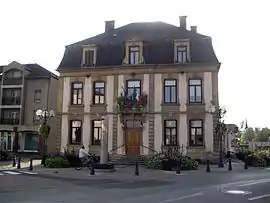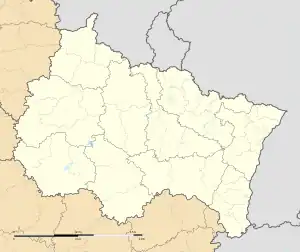Uckange | |
|---|---|
 The town hall in Uckange | |
 Coat of arms | |
Location of Uckange | |
 Uckange  Uckange | |
| Coordinates: 49°18′11″N 6°09′21″E / 49.3031°N 6.1558°E | |
| Country | France |
| Region | Grand Est |
| Department | Moselle |
| Arrondissement | Thionville |
| Canton | Fameck |
| Intercommunality | CA Val de Fensch |
| Government | |
| • Mayor (2020–2026) | Gérard Léonardi[1] |
| Area 1 | 5.56 km2 (2.15 sq mi) |
| Population | 6,976 |
| • Density | 1,300/km2 (3,200/sq mi) |
| Demonym | Uckangeois |
| Time zone | UTC+01:00 (CET) |
| • Summer (DST) | UTC+02:00 (CEST) |
| INSEE/Postal code | 57683 /57270 |
| Elevation | 150–190 m (490–620 ft) (avg. 157 m or 515 ft) |
| 1 French Land Register data, which excludes lakes, ponds, glaciers > 1 km2 (0.386 sq mi or 247 acres) and river estuaries. | |
Uckange (French pronunciation: [ykɑ̃ʒ]; German: Ückingen; Lorraine Franconian: Ickéng/Ickéngen) is a commune in the Moselle department in Grand Est in north-eastern France. The inhabitants are called Uckangeois.
History
The first traces of the Uckangeois date back to more than 6,000 years with the discovery in the 1960s of remains between Ébange and Uckange; located in a disputed area in the Middle Ages, the town of Uckange was sometimes seen as Luxembourg, over the centuries.
It belonged to the former Duchy of Luxembourg, in the seigneury of Richemont-Rodemack. The village was ceded to France in 1659 (Treaty of the Pyrenees).
The town experienced its greatest expansion at the end of the 19th century, with the establishment of STUMM font factories.
Today this factory, which produced cast iron, is closed since 1991, but a blast furnace, the U4, remains and is considered as a historical monument.
This industrial heritage is the center of a vast cultural project since 2005. The first visits began in September–October 2007.[3]
Although relatively modest, the city has known great importance in the past. Indeed, it was located near the Roman road leading to Trier, on the banks of the Moselle, which has had a railway network since 1850.
Uckange is also known by beer lovers because the compagny Ensel brewed beer from 1868 to 1940.[4]
The town is also known for its bakery specialty, the Wagotine, produced since 1961.[5]
Population
| Year | Pop. | ±% p.a. |
|---|---|---|
| 1968 | 10,326 | — |
| 1975 | 11,560 | +1.63% |
| 1982 | 9,524 | −2.73% |
| 1990 | 9,189 | −0.45% |
| 1999 | 7,905 | −1.66% |
| 2007 | 7,375 | −0.86% |
| 2012 | 6,648 | −2.05% |
| 2017 | 6,818 | +0.51% |
| Source: INSEE[6] | ||
Geography
Climate
The local climate is mild with few extremes of temperature and ample precipitation in all months. The Köppen Climate Classification subtype for this climate is "Cfb" (Marine West Coast Climate). Many areas have rainfall more than 150 days per year, although the precipitation is often of low intensity. Fog is common in autumn and winter, but thunderstorms are infrequent. Strong gales with high winds may be encountered in winter. Temperatures in the winter tend to be mild, while summer temperatures are moderate.[7]
Cultural heritage and architecture
U4 blast furnace park
The park is a cultural project housed in the old furnace. It includes, among other, art exhibitions and guided tours by former steel workers.[3]
 U4 furnace at night
U4 furnace at night The garden of the park
The garden of the park
Notable residents
- Carmelo Micciche
- Stéphane Haar
See also
References
- ↑ "Répertoire national des élus: les maires". data.gouv.fr, Plateforme ouverte des données publiques françaises (in French). 2 December 2020.
- ↑ "Populations légales 2021". The National Institute of Statistics and Economic Studies. 28 December 2023.
- 1 2 "Accueil". Parc du haut-fourneau U4.
- ↑ "Uckange: Brasserie Ensel". Bière et brasseries de Moselle. 14 September 2009.
- ↑ "La wagotine". Keldelice.
- ↑ Population en historique depuis 1968, INSEE
- ↑ "Closest city on record to Metzervisse".
External links
 Media related to Uckange at Wikimedia Commons
Media related to Uckange at Wikimedia Commons